By Kim McDarison
Clarence A. Passer was a decorated World War II soldier who lost his life on Aug. 8, 1944, after injuries sustained in battle.
While his story might have been resigned to the annuls of history, recently, according to Brad Wilcox, president of the Evergreen Cemetery Association, it came to light again. The result of its rediscovery is a shadow box on display in the association’s office, located in Evergreen Cemetery, Fort Atkinson.
For Wilcox, the resurfacing of the story of Passer, his time as a soldier, a young husband and resident of Fort Atkinson, began with a chance meeting on what he described as a rainy day in February.
History stored in a barn
Bundled against the rain and cold, Wilcox said, he and two visitors to the cemetery — siblings, Judy Jordan, Trempealeau, and Ken Harter, Casper, Wyo. — went looking for and located Passer’s grave. For the siblings, who had returned home to Fort Atkinson to visit with friends and family, Wilcox said, visiting the grave had become an important stop after Harter had located some papers and artifacts in an old chest, which had been stored in a barn on his parents’ 25-acre Fort Atkinson area farm.
With the discovery of the artifacts, the siblings learned of a family history they had earlier known little about: a marriage between their mother, Mildred, and Passer, which had ended with the soldier’s death.
After Passer’s death, Mildred married Ralph Harter, the siblings’ father, in 1946. He died in 1983. More recently, Mildred was moving to a new location and the children were helping her organize her things, which, Wilcox said, was when the discovery of the artifacts was made.
After visiting the grave, Ken Harter began corresponding with Wilcox, who had expressed interest in helping to preserve the soldier’s story. In October, Wilcox said, he received a shadow box crafted by Harter, containing a Purple Heart medal earned by Passer, his burial flag, a brass U.S. collar tab and eagle hat badge, along with a photo of Passer in uniform.
Wilcox calculated that the solder was 32 at the time of his death.
In his correspondence with Wilcox, Harter explained that his parents met while they were both working at Creamery Package in Fort Atkinson.
Sharing information about Private Clarence Passer with Wilcox, Harter wrote that he served in the U.S. Army, Company B, 47th Infantry Regiment, 9th Division and was wounded on Aug. 4, 1944, while participating in “Operation Cobra,” which, he noted — citing a book by James Jay Carafano, titled: “After D-Day” — “was a major push south to breakout from the Normandy Beachhead. The 47th Regiment was heavily involved beginning in late July of 1944.”
Service to his country
Clarence Adolph Passer was born in Fort Atkinson in 1912. Documents forwarded to Wilcox by Harter note that when Passer was 28 years old, he was living with his wife, Mildred, on Mechanic Street and was working for the Oscar Mayer Company.
Among items found by Harter were a series of letters written to his mother from the War Department, one of which, dated Dec. 12, 1944, advised her that an investigation into Passer’s death had discovered that he had died “as a result of wounds received in action on 3 August 1944.”
Subsequently, and through additional correspondence, Mildred learned that Passer had been buried in the American Cemetery at Marigny, France.
Through letters, Mildred’s attempts to learn more about her husband’s final days are documented. In October of 1945, she received a letter from Chaplain Walter K. Maude, who wrote that he had learned that Passer was wounded by mortar shell fragments in the vicinity of Troclio, France.
The letter read: “His company was in a defensive position at the time after completing a successful and important advance of eight miles against a determined enemy resistance. Clarence was given first aid immediately and evacuated to the hospital where he was given the finest medical and surgical care available, but died of wounds …”
Of Clarence, the chaplain wrote: “I have also been able to ascertain that whatever the task, and however difficult or dangerous, Clarence would willingly and cheerfully undertake it. There is no question in my mind that Clarence was one of the best and one of the bravest soldiers in this command.”
A soldier comes home, Fort family history
While Passer was initially buried in France, today his remains are interred at Evergreen Cemetery. Documentation shared by Harter shows that in 1948, Mildred applied for a headstone for military veterans to be placed in Evergreen Cemetery.
As reported within a local newspaper clipping sent by Harter to Wilcox, a funeral for Passer was held on Sept. 12, 1948, at which time he was buried in Evergreen Cemetery. According to the clipping, the body of Passer arrived on that day with a military escort.
As reported in the clipping, Passer was a graduate of “the local high school” and was employed by the James Manufacturing Company. He was a member of the Evangelical and Reformed church, and the Odd Fellows lodge.
In his correspondence with Wilcox, Harter noted that his family’s farm and the barn in which Passer’s history was discovered is on State Road 106, near Kutz Road.
Harter wrote: “We used to bike north on Kutz Road to get to our one-room school, Curtis Mills School,” which, he continued, has since been turned into a private home.
Harter recalled that his parents purchased the farm in 1955.
Additionally, Harter recalled that the second floor of the barn on the property had served as his father’s workshop, noting that Ralph Harter had worked as a machinist at Creamery Package in Fort Atkinson for 30 years.
His parents, Mildred and Ralph, were married in Illinois and together raised four children.
He described both of his parents as “accomplished musicians,” further noting that Mildred played the church organ and piano at Friedens Church for “many years,” and Ralph played the violin, as a youth, and the saxophone, trumpet, clarinet, and, after his retirement in 1962, taught himself to play the piano. Counted among his hobbies was restoring antique player pianos, Harter wrote.
Sharing some history about Mildred, Harter wrote that her father was “a strict Lutheran minister,” and his sister, Judy, thought she was born in Brooklyn, NY., and her family, at some point, moved to Ohio. Mildred’s mother died in childbirth when Mildred was born. Mildred was the last in a line of several siblings. Eventually, Mildred was sent to school in Milwaukee, and arrived in Fort Atkinson after accepting a job.
Looking to fill out the history of Passer’s time in battle, Harter said, after completing some research, he learning that the 47th Regiment came ashore “possibly at Utah beach.”
Harter wrote in an email to Wilcox that he became the family steward of artifacts pertaining to Clarence because: “I always had an interest in the military.”
Harter said that among items stored in the barn, he found Passer’s uniform dress hat, however, it was “covered in mildew,” and he opted not to save it.
Shadow box, revisited
While the shadow box including some of Passer’s artifacts remains on display in the office at Evergreen Cemetery, Wilcox said he is planning to add a few more items.
He continues to receive updates and information from Harter.
Additionally, he noted, Passer’s name is among those engraved on the war memorial monument listing Fort Atkinson’s fallen soldiers from conflicts throughout history. The monument is part of Soldier’s Memorial Monument found at the center of Evergreen Cemetery.
Wilcox also noted that Ralph Harter is buried in the cemetery.
Passer is buried in the cemetery next to his parents: Minnie, who lived between 1891 and 1963, and Adolph, who lived between 1883 and 1976.
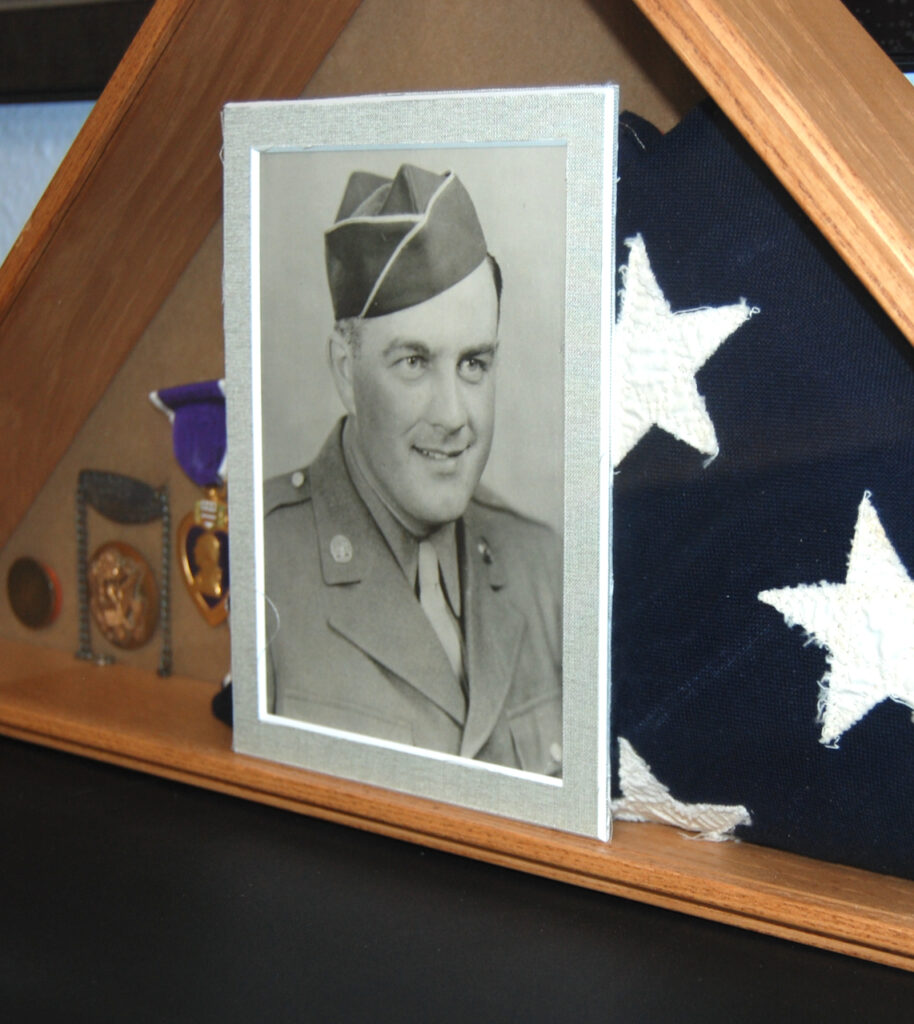
A picture of Clarence Passer in his uniform is included in a shadow box filled with his military belongings. Passer was killed in action in 1944, during World War II. His belongings were found recently in a Fort Atkinson area barn by member’s of his wife, Mildred’s family. Mildred remarried in 1946. The shadow box was given to Evergreen Cemetery in October. Kim McDarison photo.
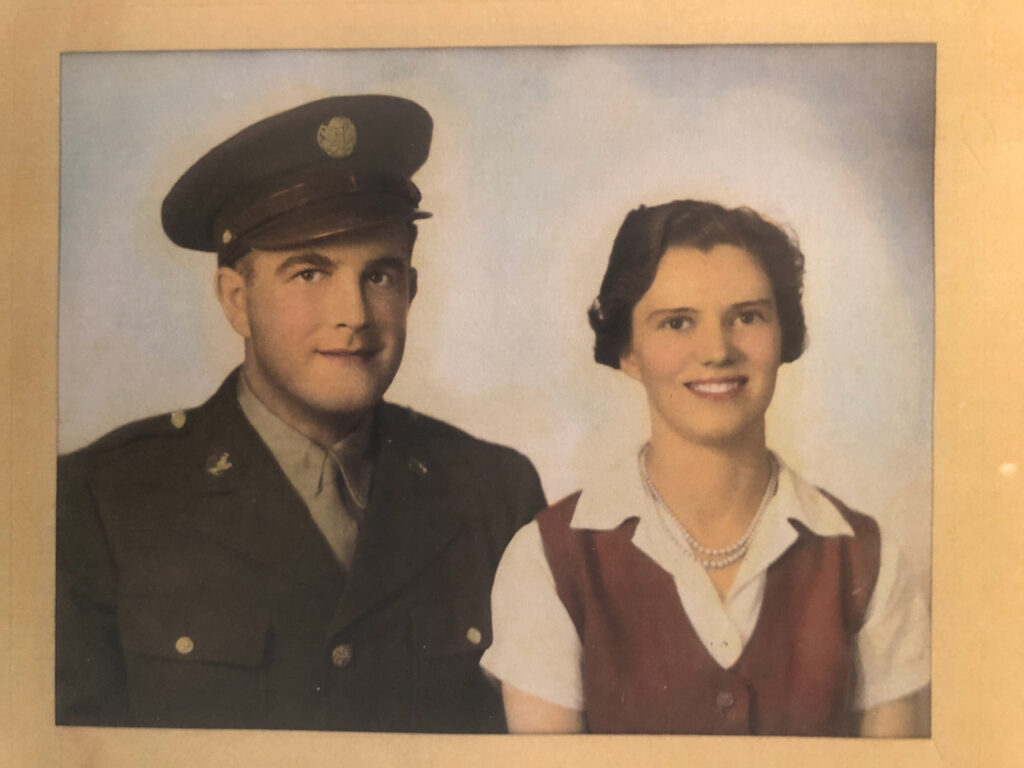
Clarence Passer and his wife, Mildred. Contributed photo.
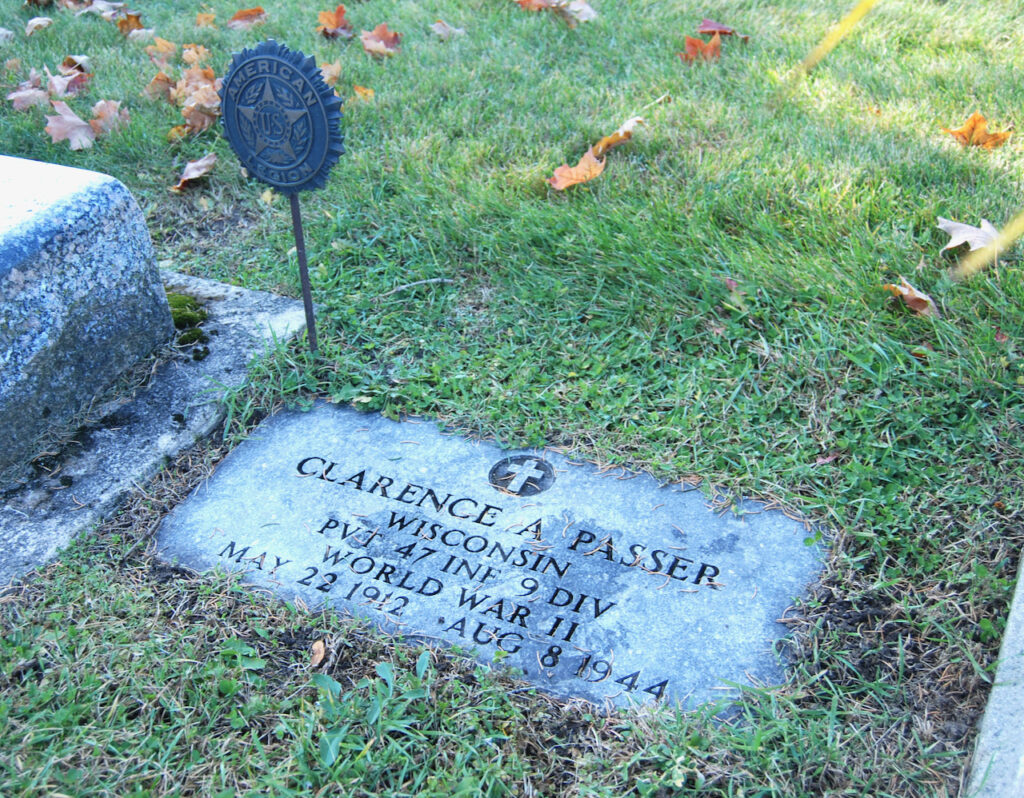
The grave of World War II soldier Clarence Passer as it appears in Evergreen Cemetery. Passer is buried next to his parents, Adolph and Minnie. Ralph Harter, Mildred’s second husband, is buried in Evergreen Cemetery. Artifacts belonging to Passer during his time of service were recently found in a barn owned by the Harter family. Kim McDarison photo.
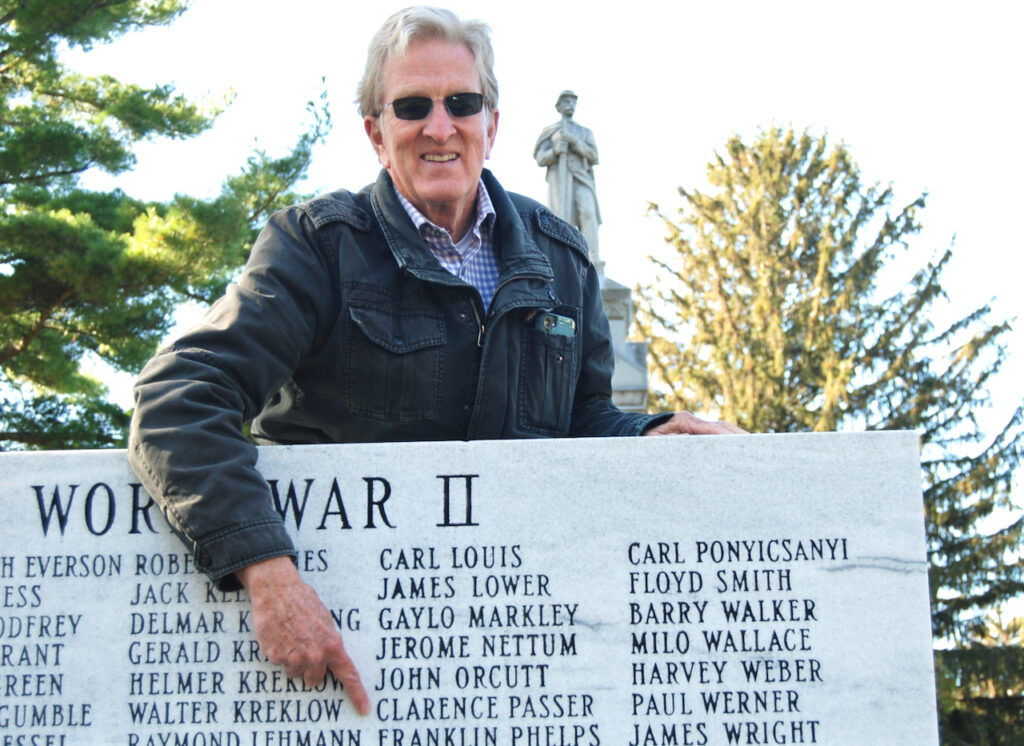
Evergreen Cemetery Association President Brad Wilcox points to the name of Clarence Passer who was killed in action during World War II. Passer died in 1944 and was buried in the American Cemetery at Marigny France, but was moved and buried in Evergreen Cemetery in 1948. Kim McDarison photo.
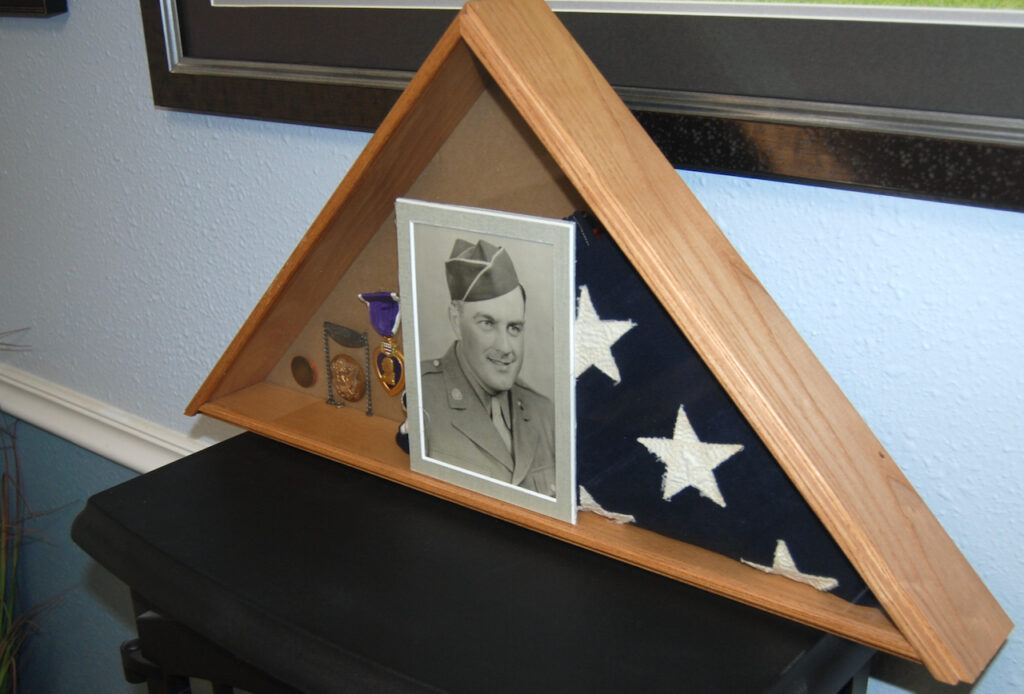
A shadow box made by Ken Harter and including artifacts found recently in a Fort Atkinson area barn owned by Harter’s parents Mildred and the late Ralph Harter, is on display in the office at Evergreen Cemetery. The box contains military possessions of Clarence Passer, who was killed in action during World War II and was Mildred’s first husband. Kim McDarison photo.
This post has already been read 1688 times!
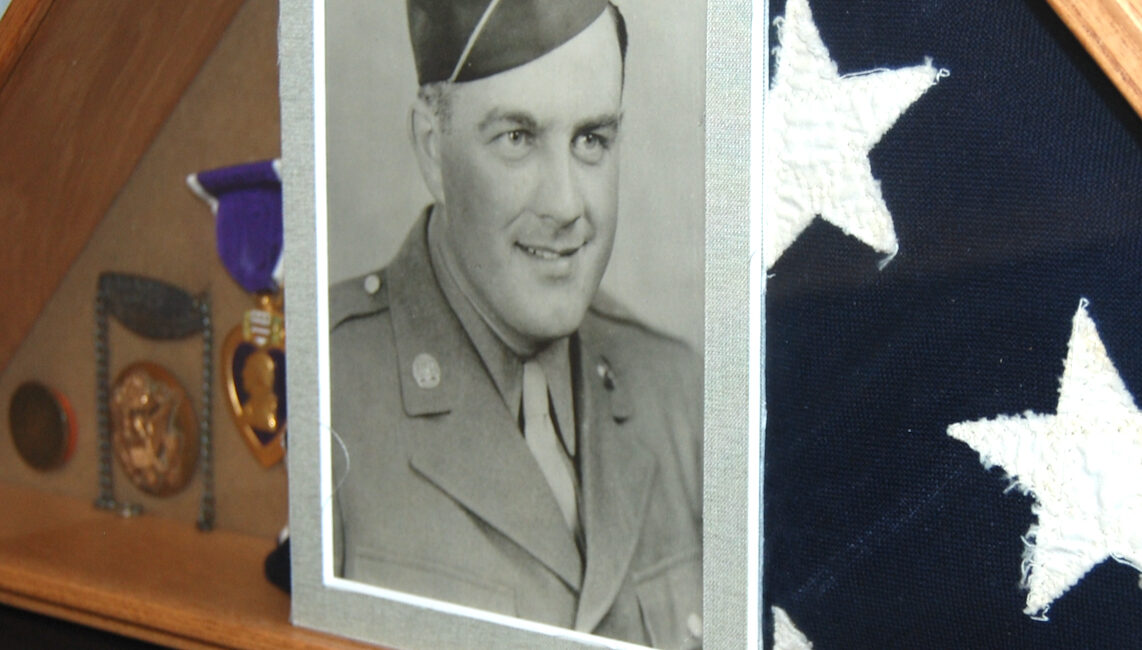
Interesting story. We are fortunate to have Brad Wilcox on our Evergreen Cemetery board. He has done an excellent job in helping to promote and preserve our history
Wonderful story about Clarence Passer. I have always enjoyed reading these types of stories.